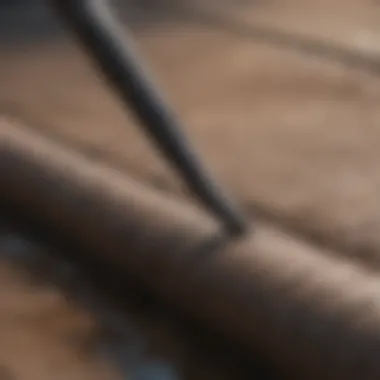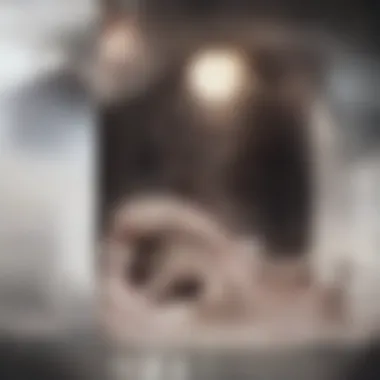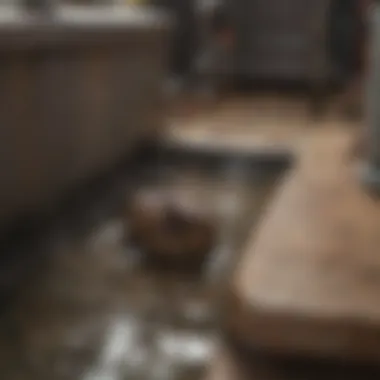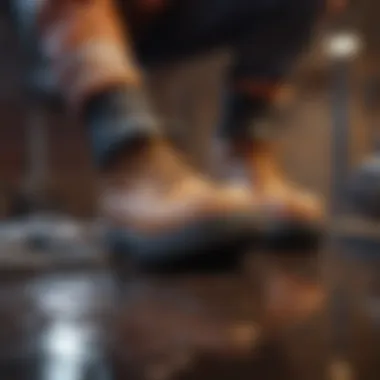Mastering the Art of Using a Drain Snake


Intro
Clogged drains can be a frustrating issue for any homeowner. Proper maintenance can sometimes prevent clogs, but when they happen, knowing how to effectively use a drain snake is essential. This article explores the technical methods for running a snake down a drain. It focuses on practical tips and strategies that can lead to successful unclogging.
Instead of relying solely on chemical solutions or professional help, using a drain snake can empower you to manage drain issues on your own. By mastering this tool, you'll save both time and money. Let's explore the value of employing a drain snake effectively.
Understanding the Drain Snake
A drain snake, or plumbing snake, is a flexible tool designed to remove blockages from pipes. Its core constituent is a long, coiled metal wire. The snake comes equipped with a rotating auger that digs into clogs made of hair, grease, or various debris. Its design enables it to navigate the twists and turns of pipes.
Regular snakes are effective for minor clogs. For more severe blockages, one might consider using a powered drain snake. These tools provide deeper penetration and stronger torque, generally making the unclogging process faster. However, the operative principle remains the same regardless of the type.
Preparation Before Use
Prior to using a drain snake, it's necessary to prepare the area and equipment:
- Gather Tools: Make sure you have the snake, gloves, a bucket to catch any debris, and a towel for cleanup.
- Protect the Area: Lay towels or old newspapers on the floor. Drains can be messy, and this precaution will save time cleaning up.
- Inspect the Drain: Look at the drain for visible signs of a clog. Understanding what you are dealing with can give insight into whether the snake will be effective.
- Wear Protective Gear: Gloves and safety goggles are recommended. This minimizes contact with harmful bacteria or sharp objects.
Running the Snake Down the Drain
When ready to unclog, follow these procedural steps to run the snake effectively:
- Insertion: Gently insert the snake into the drain until you hit resistance.
- Rotate the Snake: Turn the handle in a clockwise direction. This action will allow the auger to grab onto the clog.
- Advance Slowly: Apply gentle pressure while pushing forward. Be patient—forcing it too much may damage the pipes.
- Retrieve the Snake: Once you feel the resistance give way, it indicates the clog may be cleared. Pull the snake out slowly, allowing any debris to escape into your bucket.
- Flush the Drain: Finally, let hot water run through the drain. This will help flush out any remaining debris.
Troubleshooting Common Issues
Sometimes, challenges arise even after using a snake:
- If the clog persists, it may be beyond the reach of the snake.
- If the snake becomes stuck, rotate it back a little before pulling it out.
- Avoid pulling the snake out too forcefully, as this can lead to further complications.
If these methods do not succeed, consulting a plumbing professional may be necessary.
Safety Precautions
While using a drain snake is generally safe, it is important to follow certain safety precautions:
- Check for Damage: Ensure the snake is in good condition before use. A frayed or damaged snake can break and cause injury.
- Avoid Overexertion: Use the snake within its limit. For a larger clog, a more powerful device may be appropriate.
- Store Properly: After use, clean the snake and store it in a dry place to prevent rust and bacteria growth.
"Regular inspection and maintenance of your plumbing can reduce the frequency of clogged drains, making the use of a snake a less common necessity."
Closure
Mastering the techniques for using a drain snake empowers homeowners to address clogging issues efficiently. With preparation, understanding the mechanics, and following the outlined procedures, you can tackle even stubborn blockages. Ensure you practice safety and be mindful of the maintenance required to keep your plumbing system in optimal condition. This not only extends the life of your plumbing but also enhances your home's functionality.
Understanding the Drain Snake
Understanding the function and utility of a drain snake is critical for addressing clogged plumbing issues effectively. A drain snake, also known as a plumbing snake or auger, serves as an essential tool for clearing blockages within various drainage systems in residential and commercial settings. Recognizing its mechanics and scope empowers the user to tackle common drainage problems with confidence.
Definition and Purpose
A drain snake is a flexible tool designed to remove clogs in pipes. Its primary purpose is to dislodge and clear debris that impedes the flow of water. Often utilized as a first-line solution, it can mitigate the need for more intrusive methods such as plumbing services. Understanding its definition underscores the fundamental role it plays in maintaining proper drainage and minimizing plumbing emergencies.
Types of Drain Snakes


Different types of drain snakes cater to various clogging scenarios. Here is a closer look at their distinct features and applications:
Handheld Snakes
Handheld snakes are manually operated tools ideal for minor clogs. Their simplicity and ease of use make them a popular choice for homeowners. The key characteristic of handheld snakes lies in their flexibility, allowing them to navigate tight bends in pipes. While they are beneficial for small blockages, their effectiveness can diminish with more severe or complex clogs.
Motorized Snakes
Motorized snakes offer enhanced power for tackling stubborn clogs and are often used by professionals. The primary advantage is the efficiency they provide, as the motor drives the cable through the pipes with increased force. This type of snake is suitable for larger plumbing jobs, but it requires more skill to operate, which may be a drawback for inexperienced individuals.
Auger Snakes
Auger snakes are specialized tools designed to drill through tough clogs, such as tree roots or other hefty obstructions. Their unique feature is the helix-shaped tip that helps in breaking apart stubborn materials. Auger snakes are particularly useful in severe drainage issues, but they also necessitate a certain level of expertise due to their design and application.
When to Use a Drain Snake
Recognizing the appropriate circumstances for using a drain snake is crucial. Typical indicators for deployment include slow-draining sinks, unpleasant odors emanating from drains, or unusual gurgling sounds in plumbing fixtures. When these signs appear, it often indicates a clog forming in the pipes, prompting the need for immediate attention. Using a drain snake promptly can prevent further complications and potential damage to the plumbing system.
Preparing for the Task
Preparing properly for the task of using a drain snake is crucial. This phase determines how effective your efforts will be in unclogging a drain. A lack of preparation can lead to inefficient attempts that might not yield desired results. Taking time to understand the necessary tools, identifying the clog location, and adhering to safety precautions will make the process smoother and reduce the likelihood of injury or further issues. Each of these elements contributes in its own way, ensuring that you have both the capability and confidence to handle the task at hand.
Gathering Necessary Tools
Choosing the Right Snake
Choosing the right drain snake is fundamental for successfully tackling clogs. A drain snake is not a one-size-fits-all tool. There are various types tailored for specific situations. One key characteristic of effective snake selection is its length and flexibility. For example, a longer snake can navigate deeper pipes while a handheld version is often easier to manage in tight spaces. Opt for a model that suits the kind of blockage you anticipate, ensuring that it can reach and break through the obstruction. The unique feature of a manual snake lies in its affordability and ease of use, making it a popular choice for homeowners. However, understanding the limitations of each snake type will help to avoid frustrations during the unclogging process.
Protective Gear Requirements
When attempting to clear a drain, protective gear is not optional; it is essential. Gloves are a key characteristic of effective preparation. Using gloves protects your skin from harsh chemicals and grime found in clogged drains. A good set of gloves can create a barrier so that you can work more confidently. Strong and durable materials will withstand potential tears, which is important in a messy situation. Unique features like fingertip sensitivity are advantageous, allowing you to handle tools effectively while staying protected. Being equipped with proper protective gear also provides peace of mind, enabling you to focus on the task without worry.
Identifying the Clog Location
Signs of a Clog
Recognizing the signs of a clog is vital. Typical indicators include slow drainage, gurgling sounds, or even unpleasant odors emanating from the drain. These signs signal that a blockage is forming and needs attention. One main characteristic of recognizing these indicators is their ability to save time. Quickly identifying issues means that you spend less time guessing and more time addressing the clog. The unique feature of these signs is that they often manifest before complete blockages occur, allowing proactive measures. Prompt detection not only helps expedite your efforts but can also prevent more severe plumbing issues down the line.
Locating Access Points
Knowing how to locate access points is crucial for effective snake use. Access points are places where you can easily introduce the snake into the plumbing system. A key characteristic of successful access point identification is familiarity with your plumbing layout. This includes understanding where the clean-outs or vents are situated. Unique benefits of locating these access points include enabling easier access for tools while also minimizing the risk of damaging the plumbing. Whether it's a sink or a shower drain, knowing where to go saves time and effort, directly contributing to an efficient unclogging experience.
Safety Precautions
Using Gloves
Utilizing gloves is an effective safety precaution. Gloves not only protect you from bacteria but also from harmful substances. One significant characteristic of gloves is their ability to provide grip. This feature is crucial when handling a potentially slippery drain snake or when removing debris. Properly chosen gloves can help maintain traction while working. Despite the advantages, some might find gloves cumbersome, but the benefits of safety far outweigh these concerns, emphasizing their necessity in the unclogging process.
Securing the Area
Securing the area around a drain is another important safety precaution. This includes removing any obstacles that could lead to accidents during the unclogging process. A well-secured area promotes safety and efficiency. One key characteristic of area security is the mitigation of risks, where potential hazards like slipping can be reduced. Unique advantages include creating a distraction-free environment that allows focused effort on the task. Taking simple steps to clear the workspace can prevent injuries and enhance the overall efficiency of the task.
Executing the Snake Technique


Executing the snake technique effectively is crucial for dealing with clogged drains. This part of the article focuses on practical steps that a homeowner or DIY enthusiast can take. Understanding how to insert, maneuver, and retrieve the drain snake can significantly impact the success of clearing the blockage. Proper execution minimizes damage to plumbing systems and enhances overall effectiveness.
Inserting the Snake
Inserting the drain snake is the first move in this process. A correct insertion is essential to ensure it reaches the clog.
Aligning the Snake
Aligning the snake properly before inserting is a critical step. This alignment ensures that the snake goes in straight, reducing the chance of it bending or getting stuck inside the pipes. An important characteristic of aligning the snake is to maintain its angle with the drain opening. This method is beneficial because it allows direct access to the clog, making it easier to clear the blockage. A unique feature of alignment is that it facilitates a straight path for the snake, which tends to improve the overall efficiency of the operation.
Applying Gentle Pressure
After the snake is in, applying gentle pressure is key. This approach prevents damage to the drain pipes while letting the snake work its way through the clog. The characteristic of applying gentle pressure helps to ease the snake into the obstruction without forcing it. It is a popular choice in this guide because it mitigates the risk of pipe breakage. A unique aspect of applying gentle pressure is that it allows the operator to feel changes in resistance, indicating when the snake has reached the clog or when it has bypassed it.
Turning and Pushing the Snake
Once the snake has been inserted, the next step is to turn and push it to break up the clog. This technique requires understanding the basic mechanics of how a snake interacts with the blockage.
Understanding the Mechanics
Understanding the mechanics involved is essential. The snake must navigate through tight spaces and must be manipulated correctly to achieve the desired results. Key characteristics include recognizing the resistance generated as the snake meets the obstruction. This knowledge is valuable when deciding how much force to apply. A distinctive aspect is that the operator can learn to feel different textures and densities as the snake moves, contributing helpfully to the operation.
Adjusting to Resistance
Adjusting to resistance is also vital during this phase. If the snake meets strong resistance, it may require gentle twists or pushing. Characteristically, recognizing resistance changes indicates how to adjust the approach. This adaptability is beneficial because it means less risk of damaging the snake or the plumbing system. The unique aspect of this adjustment is learning when to apply force and when to ease off, ensuring a smoother operation overall.
Retrieving the Snake
After effectively working through the clog, the next step is retrieving the snake. This part of the process often reveals the results of your efforts in clearing the blockage.
Removing Debris
Removing debris from the snake is an important final step. The process of retrieval is crucial as it indicates the type and amount of blockage that was present. The key characteristic of removing debris is ensuring that the snake is cleared of any clogs after use. It becomes a beneficial choice because a clean snake is ready for future use. A unique feature of this action is that it allows for inspection of the materials causing the clog, contributing to your understanding of plumbing issues within your home.
Inspecting the Snake
Finally, inspecting the snake after use is equally necessary. This inspection helps determine if the snake is still in good condition. The main characteristic is checking for signs of wear or damage. It is a beneficial step as it extends the life of the tool. The unique aspect of inspecting the snake is that it trains the user to be aware of potential issues in equipment maintenance. Keeping the snake in top shape ensures efficacy in future tasks.
Regular maintenance enhances the longevity of plumbing tools and increases efficiency in handling clogs.
Troubleshooting Common Issues
Troubleshooting common issues is a critical part of using a drain snake effectively. Clogs can be persistent and may resist standard removal techniques. Understanding how to assess the situation and find solutions enhances the overall drain maintenance strategies. This section helps identify obstacles more efficiently. It contributes significantly to reducing frustration and time spent on drain issues.
Stubborn Clogs
Assessing the Situation
Assessing the situation is vital when dealing with stubborn clogs. It helps determine the severity and nature of the blockage. A proper assessment includes looking for visual signs, like slow drainage or unusual odors. This aspect offers insight into what lies beneath the surface and informs the choice of tools and methods. Knowing the type of clog can guide the homeowner in selecting appropriate techniques.
One key characteristic of this assessment is its reliance on observable symptoms rather than guesswork. By evaluating drainage history and conditions, you can gain valuable information about the clog’s origins. This is a beneficial approach for effective resolution. It contrasts starkly with trial-and-error methods that may lead to wasted effort. Understanding the clog allows for a targeted approach, thus increasing the chances of success in clearing it.
Alternative Solutions


When traditional techniques fail, exploring alternative solutions becomes necessary. This section addresses additional methods to tackle challenging clogs effectively. Alternative solutions include using chemical drain cleaners or professional services. Both offer varying degrees of effectiveness based on the type of blockage and its location.
The key characteristic of alternative solutions is their flexibility. They cater to different needs, such as budget constraints or urgency in resolving the issue. However, it is essential to consider potential disadvantages, including damage to pipes when using certain chemicals. Homeowners must carefully weigh the benefits against these risks. Ultimately, having a range of methods at one’s disposal enhances the chance of overcoming particularly stubborn blockages.
Snake Breakage
Avoiding Breakage
Avoiding breakage is an important aspect when operating a drain snake. Proper technique and attention to the snake's condition can prevent unnecessary damage. Familiarity with the specific type of snake being used is also crucial. For example, motorized snakes have different tolerances compared to manual ones. A good balance of force and caution protects both the tool and plumbing system.
The primary characteristic of focusing on avoiding breakage is the emphasis on technique. Maintaining steady pressure and not forcing the snake are effective strategies. This method reduces the risk of bending or snapping the cable. Such preventive measures provide the advantage of saving time and resources. The focus on technique ensures a smoother operation while reducing the likelihood of costly repairs.
Responding to Breakage
Responding to breakage is equally vital in the realm of plumbing repairs. If the snake does snap or encounter a blockage that cannot be cleared, quick thinking is essential. Responsibly managing the situation includes knowing how to retrieve a broken section of snake from the pipe, if possible. If not, accessing the plumbing system to locate the blockage may be necessary.
The key characteristic of addressing breakage lies in preparedness. Homeowners should have a plan in place for when things do not go as expected. This proactive approach helps minimize delay and frustration. Being informed about how to deal with breakage creates a better sense of control over the situation. While it may not always be possible to avoid issues entirely, having a comprehensive strategy eases the process.
Post-Use Maintenance
Maintaining your drain snake after use is essential to ensure its longevity and effectiveness. This section outlines two main components of post-use maintenance: cleaning the snake and inspecting plumbing systems. Proper handling after usage can prevent future clogs, maintain the tool's condition, and avoid unnecessary expenses from poor maintenance.
Cleaning the Snake
Removing Residue
Removing residue is a critical step in cleaning the snake. After using the device, you will often find buildup of hair, grease, and other debris. It’s important to remove this material promptly to prevent corrosion of metal components and ensure hygienic storage. The key characteristic of residue removal is that it directly affects the efficacy of the tool for future use.
When the snake is cleaned well, it operates efficiently, reducing the risk of clogging and enhancing the speed of the job. A significant advantage of removing residue is the prevention of embedment in the snake, which could lead to damage or decreased performance. On the downside, poorly handled residue removal can lead to mess and unwanted odors if left unattended.
Proper Storage
Proper storage of the drain snake is another essential aspect of maintenance. After cleaning, the snake should be stored in a dry, secure place to avoid rust and mechanical failure. The essential feature of proper storage includes preventing tangles and ensuring that the snake is not exposed to extreme environmental conditions.
Storing the snake effectively keeps it easily accessible while safeguarding its structure. The advantage of this approach is that it promotes a longer lifespan for the tool and reduces downtime during future plumbing tasks. However, improper storage can lead to physical damage or operational issues, requiring additional repairs or replacements.
Inspecting Plumbing Systems
Periodic Checks
Periodic checks of the plumbing system contribute to preventative maintenance in your home. By regularly inspecting pipes, you can identify signs of wear, leaks, or small clogs before they develop into larger issues. The key attribute of periodic checks is that they save time and money in the long run.
Regular inspections help maintain a healthy plumbing system by catching potential problems early. They improve your overall home environment, making it more comfortable and functional. Uncovering issues proactively prevents emergency repair situations, which are often costly and disruptive. On the other hand, if inspections are neglected, significant plumbing issues may arise that require people to use costly emergency services.
When to Call a Professional
Knowing when to call a professional is crucial for homeowners. Some clogs or plumbing issues may seem manageable at first but require expert intervention due to their complexity or severity. Recognizing the key characteristic of this decision reflects a balance between DIY effort and professional skill.
Engaging a professional ensures that the job is done correctly, leveraging their tools and expertise to address stubborn issues effectively. This professional touch can prevent further damage to the plumbing system that an unskilled attempt might create. However, the drawback can often be the cost associated with hiring a plumber. Homeowners must weigh the urgency and complexity of their plumbing issues against their budget before making this decision.
Finale
Summary of Key Points
- Familiarity with Drain Snakes: Knowing the different types of drain snakes, such as handheld snakes, motorized snakes, and auger snakes, is crucial. Each type serves its unique purpose and can be more suitable for specific situations.
- Preparation is Essential: Gathering the necessary tools, identifying the clog location, and taking safety precautions set the stage for successful drain clearing. Ensuring that you are fully prepared minimizes the risk of complications during the process.
- Technique Execution: Properly inserting, turning, and retrieving the snake is fundamental for effectively addressing clogs. Understanding the mechanics involved helps in adjusting tactics when faced with resistance.
- Maintenance Matters: Cleaning and inspecting your drain snake post-use are imperative for its longevity and future efficiency. Regularly checking your plumbing systems can also prevent major blockages from developing.
Final Recommendations
- Practice Regular Maintenance: Regular check-ups of your plumbing should be a standard part of home maintenance. This act can prevent clogs from becoming significant issues in the first place.
- Choose the Right Tools for the Job: Invest in a quality drain snake that is appropriate for the types of clogs you frequently encounter. Understanding which tool to use can be the difference between easy clearance and a frustrating experience.
- Don’t Hesitate to Call Professionals When Needed: While DIY methods can often be successful, there are times when professional assistance is necessary. If a clog persists despite your efforts, seeking expert help can save time and prevent further damage.
Mastering the use of a drain snake will equip you with practical skills that are not only useful today but valuable for future plumbing challenges.







